For the 2025 school year, there are 2 public middle schools serving 1,132 students in Dillon 04 School District. This district's average middle testing ranking is 3/10, which is in the bottom 50% of public middle schools in South Carolina.
Public Middle Schools in Dillon 04 School District have an average math proficiency score of 19% (versus the South Carolina public middle school average of 33%), and reading proficiency score of 31% (versus the 46% statewide average).
Minority enrollment is 66% of the student body (majority Black), which is more than the South Carolina public middle school average of 52% (majority Black).
Overview
This School District
This State (SC)
# Schools
7 Schools
352 Schools
# Students
3,780 Students
221,816 Students
# Teachers
217 Teachers
15,785 Teachers
Student : Teacher Ratio
17:1
17:1
District Rank
Dillon 04 School District, which is ranked within the bottom 50% of all 76 school districts in South Carolina (based off of combined math and reading proficiency testing data) for the 2021-2022 school year.
The school district's graduation rate of 80% has decreased from 89% over five school years.
Overall District Rank
#64 out of 81 school districts
(Bottom 50%)
(Bottom 50%)

Math Test Scores (% Proficient)
26%
41%
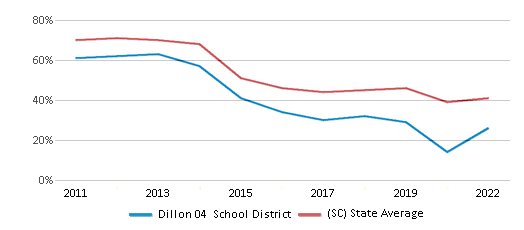
Reading/Language Arts Test Scores (% Proficient)
35%
52%
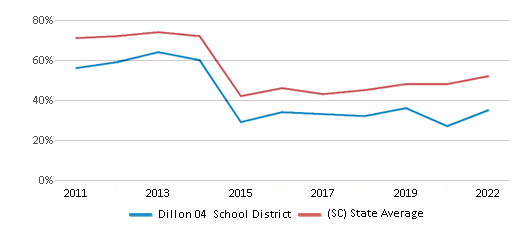
Science Test Scores (% Proficient)
31%
50%
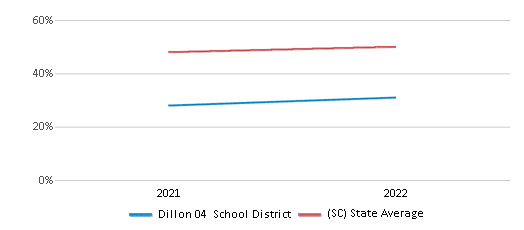
Graduation Rate
80%
84%
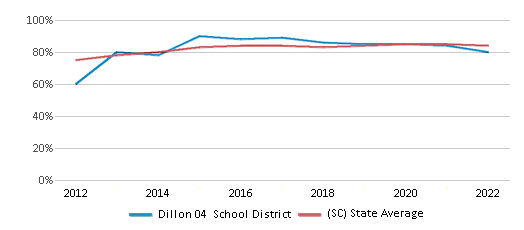
Students by Ethnicity:
Diversity Score
0.59
0.66
# American Indian Students
79 Students
716 Students
% American Indian Students
2%
n/a
# Asian Students
10 Students
3,913 Students
% Asian Students
n/a
2%
# Hispanic Students
221 Students
28,487 Students
% Hispanic Students
6%
13%
# Black Students
2,216 Students
68,879 Students
% Black Students
59%
31%
# White Students
977 Students
106,747 Students
% White Students
26%
48%
# Hawaiian Students
1 Student
263 Students
% Hawaiian Students
n/a
n/a
# Two or more races Students
276 Students
12,741 Students
% of Two or more races Students
7%
6%
Students by Grade:
# Students in PK Grade:
134
1,376
# Students in K Grade:
284
4,750
# Students in 1st Grade:
277
4,911
# Students in 2nd Grade:
328
5,020
# Students in 3rd Grade:
243
5,182
# Students in 4th Grade:
237
5,185
# Students in 5th Grade:
321
5,841
# Students in 6th Grade:
265
53,112
# Students in 7th Grade:
274
59,443
# Students in 8th Grade:
274
60,172
# Students in 9th Grade:
324
4,774
# Students in 10th Grade:
325
4,352
# Students in 11th Grade:
269
3,992
# Students in 12th Grade:
225
3,706
# Ungraded Students:
-
-
District Revenue and Spending
The revenue/student of $12,360 in this school district is less than the state median of $15,220. The school district revenue/student has stayed relatively flat over four school years.
The school district's spending/student of $11,808 is less than the state median of $14,817. The school district spending/student has stayed relatively flat over four school years.
Total Revenue
$47 MM
$12,084 MM

Spending
$45 MM
$11,764 MM

Revenue / Student
$12,360
$15,220

Spending / Student
$11,808
$14,817
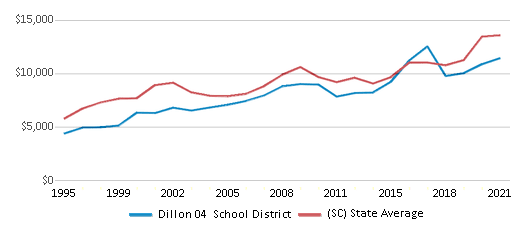
Best Dillon 04 School District Public Middle Schools (2025)
School
(Math and Reading Proficiency)
(Math and Reading Proficiency)
Location
Grades
Students
Rank: #11.
Lake View High School
(Math: 26% | Reading: 42%)
Rank:
Rank:
3/
Bottom 50%10
401 East Third Avenue
Lake View, SC 29563
(843) 759-3009
Lake View, SC 29563
(843) 759-3009
Grades: 6-12
| 517 students
Rank: #22.
Dillon Middle School
(Math: 16% | Reading: 26%)
Rank:
Rank:
1/
Bottom 50%10
1803 Joan Drive
Dillon, SC 29536
(843) 774-1212
Dillon, SC 29536
(843) 774-1212
Grades: 6-8
| 615 students
Recent Articles

Year-Round Or Traditional Schedule?
Which is more appropriate for your child? A year-round attendance schedule or traditional schedule? We look at the pros and cons.

Why You Should Encourage Your Child to Join a Sports Team
Participating in team sports has a great many benefits for children, there is no doubt. In this article you will learn what those benefits are.

White Students are Now the Minority in U.S. Public Schools
Increasing birth rates among immigrant families from Asia and Central and South America, combined with lower birth rates among white families, means that for the first time in history, public school students in the United States are majority-minority. This shift in demographics poses difficulties for schools as they work to accommodate children of varying language abilities and socio-economic backgrounds.





